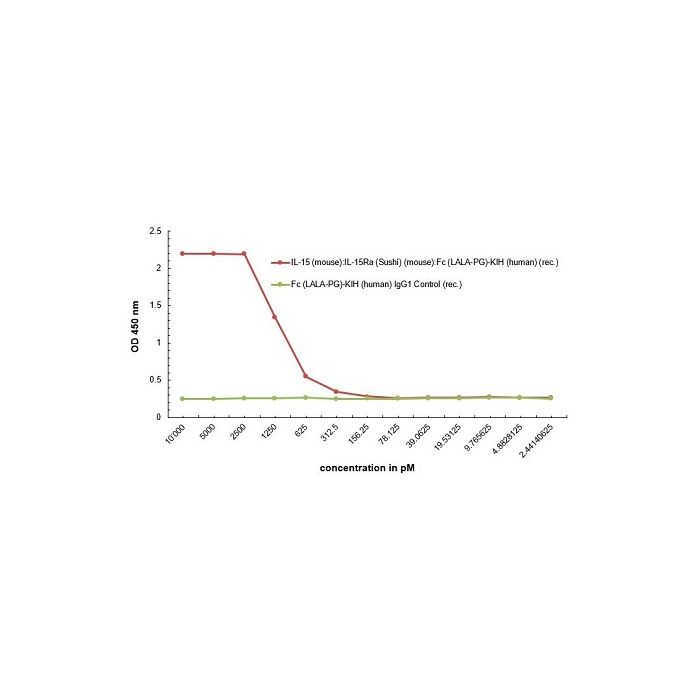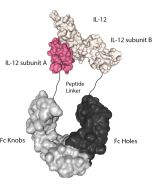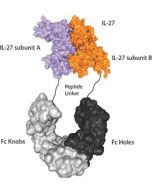Cookie Policy: This site uses cookies to improve your experience. You can find out more about our use of cookies in our Privacy Policy. By continuing to browse this site you agree to our use of cookies.
AdipoGen Life Sciences
IL-15 (mouse):IL-15Ra (Sushi) (mouse):Fc (LALA-PG)-KIH (human) (rec.)

Method: Activity of IL-15 (mouse):IL-15Ra (Sushi) (mouse):Fc (LALA-PG)-KIH (human) (rec.) is measured using proliferation of CTLL-2 cells. CTLL-2 are grown in RPMI medium, glutamine, 10% FBS, 100 IU IL-2 (#AG-40B-0224) and different concentrations of IL-15 (mouse):IL-15Ra (Sushi) (mouse):Fc (LALA-PG)-KIH (human) (rec.) (#AG-40B-0257) or the control protein Fc (LALA-PG)-KIH (human) IgG1 Control (rec.) (#AG-35B-0018). Cell proliferation is quantified using PMS/MTS (CellTiter 96® AQueous One Solution Cell Proliferation Assay, Promega).
| Product Details | |
|---|---|
| Synonyms | InVivoKine™; IL-15 (mouse):IL-15Ra (Sushi) (mouse):Fc (LALA-PG) Knobs-into-Holes (human) (rec.); Interleukin-15:Interleukin-15Ra (Sushi Domain) |
| Product Type | Protein |
| Properties | |
| Source/Host | HEK 293 cells. Produced using animal component-free medium. |
| Sequence |
IL-15 (aa 49-162) (mouse):Fc (LALA-PG) (human) Knobs and IL-15Ra (Sushi Domain) (aa 34-98) (mouse):Fc (LALA-PG) (human) Holes form the IL-15 (mouse):IL-15Ra (Sushi) (mouse):Fc (LALA-PG)-KIH (human) using the Knobs-into-Holes technology (see reference: J.B. Ridgway, et al.; Protein Eng. 9, 617 (1996)). |
| Crossreactivity | Mouse |
| Biological Activity |
Induces mouse CTLL2 (T cell line) proliferation with an ED50 of <300pM. |
| MW | ~50kDa and 40kDa (SDS-PAGE) |
| Purity | ≥95% (SDS-PAGE) |
| Endotoxin Content | <0.001EU/μg purified protein (LAL test) |
| Concentration | 1mg/ml after reconstitution. |
| Reconstitution | Reconstitute with 50μl sterile water. |
| Accession Number | P48346, Q60819 |
| Formulation | Lyophilized. Contains PBS |
| Protein Negative Control |
Fc (LALA-PG)-KIH (human) IgG1 Control (rec.) (Prod. No. AG-35B-0018) |
| Other Product Data |
UniProt link P48346: IL-15 (mouse) UniProt link Q60819: IL-15Ra (mouse) |
| Shipping and Handling | |
| Shipping | BLUE ICE |
| Short Term Storage | +4°C |
| Long Term Storage | -20°C |
| Handling Advice |
After reconstitution, prepare aliquots and store at -20°C. Avoid freeze/thaw cycles. Centrifuge lyophilized vial before opening and reconstitution. PBS containing at least 0.1% BSA should be used for further dilutions. |
| Use/Stability |
Stable for at least 6 months after receipt when stored at -20°C. Working aliquots are stable for up to 3 months when stored at -20°C. |
| Documents | |
| MSDS |
 Download PDF Download PDF |
| Product Specification Sheet | |
| Datasheet |
 Download PDF Download PDF |
Interleukin-15 (IL-15) is a cytokine that belongs to the interleukin-2 (IL-2) family and is essential for the development, proliferation and activation of immune cells, including natural killer (NK) cells, T cells and B cells. IL-15, unlike other cytokines, is widely expressed by many cell types including monocytes, macrophages, DC, fibroblasts, epithelial cells and skeletal muscle cells, but surprisingly not by T cells. IL-15 signals through a heterotrimeric receptor that is composed of the common γ chain (γc) subunit (CD132), the β chain (βc) subunit (IL-2/IL-15R, CD122) and the IL-15 specific α subunit IL-15Rα (CD215). IL-15 binding to its trimeric receptor induces JAK1 activation which phosphorylates STAT3 via the beta chain, and JAK3 activation which phosphorylates STAT5 via the γ chain. IL-15, like IL-2, stimulates the proliferation of T cells, induces the generation of cytotoxic lymphocytes and memory phenotype CD8 T cells, and stimulates the proliferation and maintenance of natural killer (NK) cells. In contrast to IL-2, IL-15 does not mediate activation-induced cell death (AICD) and does not consistently activate Tregs. If IL-2 is a promiscuously secreted molecule, IL-15 is locally secreted in small quantities where membrane-bound IL-15 induces signals at an immunological synapse. IL-15Rα (especially its sushi domain) acts more like a stabilizing and synergistic element (chaperone molecule) of IL-15, assisting IL-15 in its trans-presentation. The new recombinant protein IL-15 (mouse):IL-15Ra (Sushi) (mouse):Fc (LALA-PG)-KIH (human) (rec.) is an enhanced form of IL-15 with an extended half-life that stimulates the proliferation of T cells, B cells and NK cells in vivo, and increases its anti-tumor activity.
The protein IL-15 (mouse):IL-15Ra (Sushi) (mouse):Fc (LALA-PG)-KIH (human) (rec.) is produced by using two different vectors, one encoding for the IL-15 (mouse):Fc (LALA-PG) Knobs sequence (synthesizing a protein of 50kDa) and one encoding for the IL-15Ra (Sushi) (mouse):Fc (LALA-PG) Holes sequence (synthesizing a protein of 40kDa). Both vectors transfected into HEK 293 cells produce both Fc molecules (Knobs-into-Holes technology; J.B. Ridgway, et al.; Protein Eng. 9, 617 (1996)) required for dimerization and for secretion of the final protein IL-15 (mouse):IL-15Ra (Sushi) (mouse):Fc (LALA-PG)-KIH (human) (rec.). The LALA-PG mutations inhibit binding to FcγRs and C1q while FcRn binding and Fc stability remain unaffected.
InVivoKines™ are a new generation of recombinant fusion proteins for immunotherapeutic, preclinical and translational in vivo research, developed and manufactured by AdipoGen Life Sciences.








